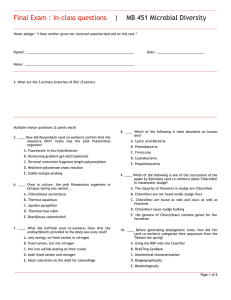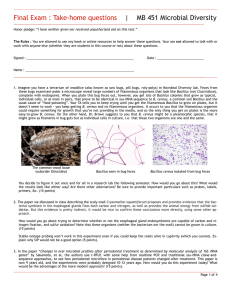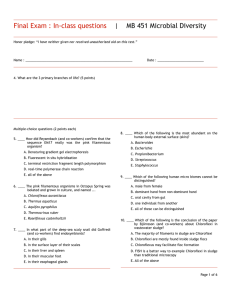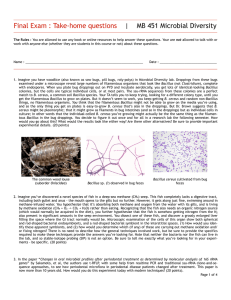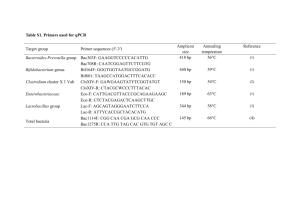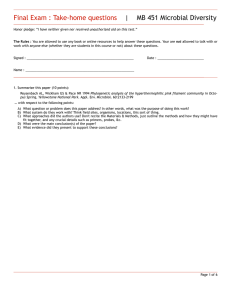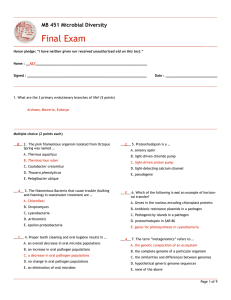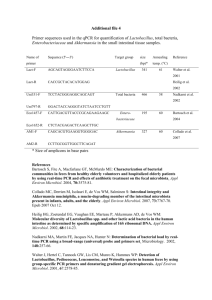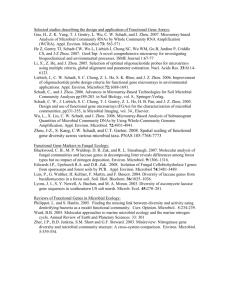Final Exam : Take-home questions
advertisement
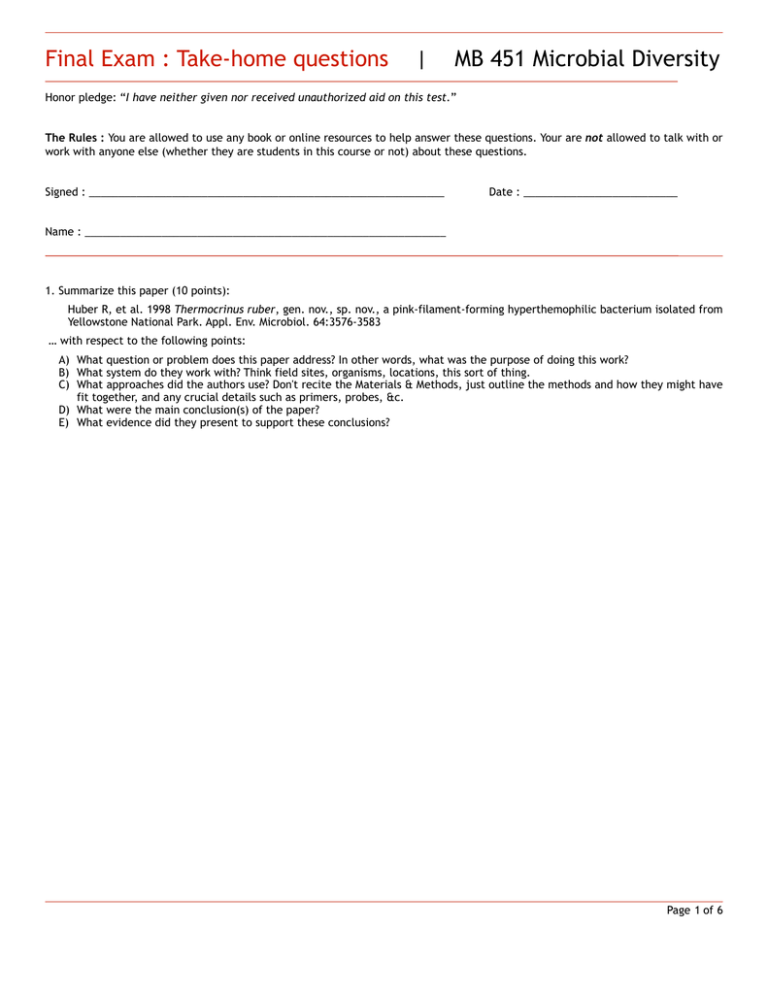
Final Exam : Take-home questions | MB 451 Microbial Diversity Honor pledge: “I have neither given nor received unauthorized aid on this test.” The Rules : You are allowed to use any book or online resources to help answer these questions. Your are not allowed to talk with or work with anyone else (whether they are students in this course or not) about these questions. Signed : ____________________________________________________________ Date : __________________________ Name : _____________________________________________________________ 1. Summarize this paper (10 points): Huber R, et al. 1998 Thermocrinus ruber, gen. nov., sp. nov., a pink-filament-forming hyperthemophilic bacterium isolated from Yellowstone National Park. Appl. Env. Microbiol. 64:3576-3583 … with respect to the following points: A) What question or problem does this paper address? In other words, what was the purpose of doing this work? B) What system do they work with? Think field sites, organisms, locations, this sort of thing. C) What approaches did the authors use? Don't recite the Materials & Methods, just outline the methods and how they might have fit together, and any crucial details such as primers, probes, &c. D) What were the main conclusion(s) of the paper? E) What evidence did they present to support these conclusions? Page 1 of 6 2. Summarize this paper (10 points): Venter JC, et al., 2004 Environmental genome shotgun sequencing of the Sargasso sea. Science 304:66-74. … with the following points: A) What question or problem does this paper address? In other words, what was the purpose of doing this work? B) What system do they work with? Think field sites, organisms, locations, this sort of thing. C) What approaches did the authors use? Don't recite the Materials & Methods, just outline the methods and how they might have fit together, and any crucial details such as primers, probes, &c. D) What were the main conclusion(s) of the paper? E) What evidence did they present to support these conclusions? Page 2 of 6 3. In MB 452 Microbial Diversity lab, imagine you have a terrarium of woodlice (also known as sow bugs, pill bugs, roly-polys). Feces from these bugs examined under a microscope reveal large numbers of filamentous organisms that look like Bacillus, complete with endospores. When you plate this bug feces out, however, you get lots of Bacillus colonies that grow as typical, individual cells, or at most in pairs, that prove to be identical in ssu-rRNA sequence to that of B. cereus, which is a common soil Bacillus and a common cause of food “poisoning”. Your TA tells you to keep trying until you get the filamentous Bacillus to grow on plates, but it doesn’t seem to work. It occurs to you that they could require something for growth that you’re not providing in the media, and so the only thing you get on plates is the more easy-to-grow ubiquitous B. cereus. On the other hand, Dr. Brown suggests to you that B. cereus might be a pleomorphic species, that it might grow as filaments in bug guts but as individual cells in culture. The common wood louse Bacillus seen in bug feces Bacillus cereus isolated from bug feces You decide to figure it out once and for all in a research lab the following semester. How would you go about this? What would the results look like either way? Be sure to provide important particulars such as probes, labels, primers, &c. (10 points) Page 3 of 6 4. The paper we discussed in class describing the scaly snail Crysomallon squamiferum proposes and provides evidence that the bacterial symbiont in the esophageal glands fixes both carbon and nitrogen, as well as provides the animal energy from sulfide oxidation. But this evidence is pretty indirect, it would be nice to confirm these conclusions more directly, using some other approach. How would you go about testing whether or not the esophageal gland endosymbionts are capable of carbon and nitrogen fixation? Note that these organisms cannot be grown in culture. (10 points) NOTE : Stable-isotope probing won’t work in this experiment even if you could keep the snails alive in captivity (which you cannot). For 5 extra credit points, explain why SIP would not be an option. Page 4 of 6 5. In the paper “Changes in oral microbial profiles after periodontal treatment as determined by molecular analysis of 16S rRNA genes” by Sakamoto, et al, the authors primarily use t-RFLP, with some help from realtime PCR and traditional ssu-rRNA cloneand-sequence approaches, to see how periodontal microflora in periodontal disease patients changed after treatment. This paper is now 8 years old, and the experiments were probably designed about 10 years ago. How would you do this experiment today? What would be the advantages of the more modern approach? (10 points). Page 5 of 6 USE THIS PAGE TO FINISH ANY ANSWERS YOU’RE BEING LONG-WINDED ABOUT Page 6 of 6 Final Exam : In-class questions | MB 451 Microbial Diversity Honor pledge: “I have neither given nor received unauthorized aid on this test.” Signed : ____________________________________________________________ Date : __________________________ Name : _____________________________________________________________ 6. What are the 3 primary branches of life? (5 points) Multiple-choice questions (1 point each) 7. ____ Proteorhodopsin is a light-driven … A. chloride pump B. proton pump C. calcium cation channel D. ATPase E. none of the above 10. ____ These filamentous organisms are generally considered to be problematic in wastewater treatment digesters. A. Cyanobacteria B. Chlorobi C. Chloroflexi D. Choanoflagellates E. Thermocrinus 8. ____ A “phylogenetic probe” is … A. an ion-specific probe coated in specific oligonucleotides that can measure organisms in situ B. a program that scans metagenomic sequences for phylogenetic signal to identify the source organism C. A fluorescently-labeled oligonucleotide complementary to a region of rRNA used in FISH experiments D. a heavy-isotope-labeled growth substrate used to label rRNA in SIP experiments 11. ____ The point of a DGGE gel is to separate DNAs by ... A. size B. resistance to denaturation C. affinity for ethidium bromide D. charge/mass ratio E. buoyant density E. none of the above 9. ____ “Unifrac” is ... A. a measure of the similarity of microbial populations B. a 3D plot of principle-component analysis C. a fractals-based treeing algorithm D. a chimera-detecting algorithm E. none of the above 12. ____ The predominant human skin microbes seem to be ... A. Proteobacteria B. Arthrobacter & Corynebacterium C. Proprionibacteria & Staphylococcus D. Bacteroides & Clostridium E. none of the above Page 1 of 7 13. ____ The predominate human gut (fecal) microbes seem to be ... A. Proteobacteria B. Arthrobacter & Corynebacterium C. Proprionibacteria & Staphylococcus D. Bacteroides & Clostridium E. none of the above 14. ____ An appropriate label in a SIP experiment to identify autotrophs would be ... A. 15N 2 B. Na H13C03 C. 3H-glucose D. γ32P-ATP E. H218O 15. ____ Sterilizing impacts ended 3,800 million years ago in Earth. About how long after this is it before there good evidence for life? A. 20 minutes B. 1.65 million years C. 200 million years D. 2.5 billion years E. 3,799,993,950 years 16. ____ What is the name of the pink filamentous organism in Octopus Spring? A. Epistylus galea B. Korarchaeum cryptofilum C. Thermocrinus ruber D. Thermus aquaticus E. none of the above Short-answer questions (5 points each) 17. What is a Chimera? Where do they come from? 18. What is horizontal transfer? How can it be detected? Page 2 of 7 19. Describe the most interesting thing you learned from any of the papers we reviewed in class. Make sure to include why you think this is interesting - what does it mean to you? (This is not a superficial question, please give a substantial answer) Page 3 of 7 Essay questions (10 points each) 18. Describe in detail the technology behind how one of the following microbial communities was surveyed: • The human skin microbiome • Chloroflexi in wastewater sludge • Bacteria in different temperature zones of a Tibetian hot spring • Oral microflora before and after treatment for periodontal disease Page 4 of 7 19. Describe in detail any paper we’ve discussed in this course. YOU ARE NOT ALLOWED TO USE ANY PAPER YOU’VE ALREADY DESCRIBED IN THIS EXAM, INCLUDING THE TAKE-HOME SECTION! You are allowed to use papers we reviewed in the Discussion session if you wish. Page 5 of 7 USE THIS PAGE TO FINISH ANY ANSWERS YOU’RE BEING LONG-WINDED ABOUT XKCD.com Page 6 of 7 Papers reviewed in class: • Reysenbach AL, Wickham GS & Pace NR 1994 Phylogenetic analysis of the hyperthermophilic pink filament community in Octopus Spring, Yellowstone National Park. Appl. Env. Microbiol. 60:2133-2199 • Huber R, et al. 1998 Thermocrinus ruber, gen. nov., sp. nov., a pink-filament-forming hyperthemophilic bacterium isolated from Yellowstone National Park. Appl. Env. Microbiol. 64:3576-3583 • Goffredi SK, Waren A, Orphan VJ, Van Dover CL & Vrijenhoek RC 2004 Novel forms of structural integration between microbes and a hydrothermal vent gastropod from the Indian Ocean. Appl Env Microbiol 70:3082-3090 • Costello EK, Lauber CL, Hamady M, Fierer N gordon JI & Knight R 2009 Bacterial community variation in human body habitats across space and time. Science 326:1694-1697 • Björnsson L, Hugenholtz P, Tyson GW & Blackall LL. 2002 Filamentous Chloroflexi (green non-sulfur bacteria) are abundant in wastewater treatment processes with biological nutrient removal. Microbiol. 148:2309-2318. • Yim LC, Hongmei J, Aitchison JC & Pointing SB 2006 Highly diverse community structure in a remote central Tibetan geothermal spring does not display monotonic variation to thermal stress. FEMS Microbiol Ecol. 57:80-91 • Sakamoto M, Huang Y, Ohnishi M, Umeda M, Ishikawa I & Benno Y. 2004 Changes in oral microbial profiles after peridontal treatment as determined by molecular analysis of 16S rRNA genes. J. Med. Microbiol. 53:563-571. • Moreno Am, Matz C, Kjelleberg S & Manefield M 2010 Identification of ciliate grazers of autotrophic Bacteria in ammonia-oxidizing activated sludge by RNA stable isotope probing. AEM 76:2203-2211 • Beja O, et al. 2000 Bacterial rhodopsin: Evidence for a new type of phototrophy in the sea. Science 289:1902-1906. • Nelson KE, . . . Venter JC, Fraser CM. 1999. Evidence for lateral gene transfer between Archaea and bacteria from genome sequence of Thermotoga maritima. Nature 399:323-329 • Venter JC, et al., 2004 Environmental genome shotgun sequencing of the Sargasso sea. Science 304:66-74. • Rasmussen, B. 2000 Filamentous microfossils in a 3,235-million-year-old volcanogenic massive sulphide deposit. Nature 405:676-679 Papers reviewed in the Discussion sessions (you can use these if you wish): • Murgia C, Pritchard JK, Kim SY, Fassati A, and RA Weiss 2006 Clonal origin and evolution of a transmissible cancer. Cell 126:477-487 • Wolfe-Simon F, et al. 2010 A Bacterium that can grow by using arsenic instead of phosphorous. ScienceXpress 10.1126 • Drancourt, M., Aboudharam, G., Signoli, M., Dutour, O., and Raoult, D. 1998 Detection of 400-year-old Yersinia pestis DNA in human dental pulp: An approach to the diagnosis of ancient septicemia. Proc. Natl. Acad. Sci. USA 95:12637-12640. • Drancourt, et al., 2004 Emerg Inf Diseases 10:1585 Genotyping, Orientalis-like Yersina pestis, and Plague Pandemics. • Soto C and Castilla J 2004 The controversial protein-only hypothesis of prion propagation. Nature Medicine 10:S63-S67 • Somerville RA 2002 TSE agent strains and PrP: Reconciling structure and function. TiBS 27:606-612 • Rault D, et al. 2008 Nanobacteria are mineralo fetuin complexes. PLoS Pathogens 4:e41 • Fierer N, Hamady M, Lauber CL and R Knight 2008 The influence of sex, handedness, and washing on the diversity of hand surface bacteria. PNAS 105:17994-17999 • Giovannoni SJ, et al. 2005 Genome streamlining in a cosmopolitan oceanic bacterium. Science 309:1242-1245 XKCD.com Page 7 of 7
